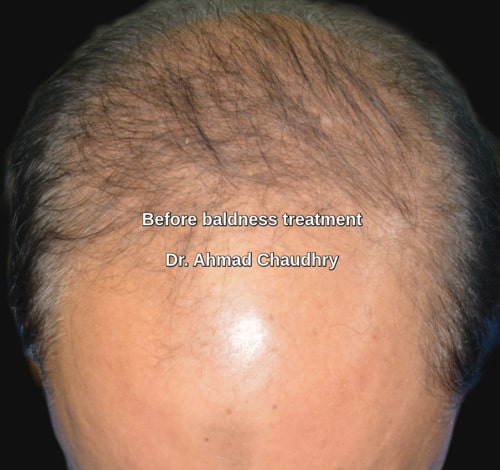Pattern baldness is a condition in which a person has little or no hair growth on the scalp. It can cause gaps in growth and can also result in shiny skin patches with no growth at all. The degree and pattern of hair loss varies according to the causes as well as gender. The most common cause is male and female pattern baldness, which is also known as androgenic alopecia. Extreme forms of alopecia involve the loss of scalp hair and in the most extreme case it can result in alopecia universalis, which means all the body hair falls out and there is no growth in any region of the body.
Pattern baldness genetics
Male pattern baldness is related to the genetic set up and is the most common cause in males. Usually it follows a pattern in which the hairline recedes to a great extent while also lost from the top or crown of the head. Each strand of hair grows in a cavity in the skin called follicle. It occurs when the follicle shrinks in size but does not lose viability gradually. The follicle does not grow new strand, however, the follicles remain alive, which suggest that it’s possible to grow new hair. In most cases, the male androgenetic alopecia begins at the frontline. This moves backward with time forming an M shape and becomes thinner and lesser in number. This creates a U shaped pattern around the sides of the head. Hair weaving, wigs, or change of hairstyle may disguise in the beginning stages of alopecia.
Androgenetic alopecia permanent solution
Hair transplant provides a permanent solution for androgenetic alopecia. Each hair grows for a couple of years and then falls out, and in female pattern alopecia, the duration of growth reduces and the new strand produced is thinner and finer. The reason for female thinning may be related to aging, hormonal changes or family history. However, with time, younger women are also experiencing female pattern baldness. Women often use harsh chemicals and heat which exposes the strands to extremities and that also results in the problem. In female, hair thins mainly on the top and crown of the scalp. Usually this starts with an increase in gaps. This kind of thinning is permanent but there are a few medicines available that can positively affect the growth. The most popular medicine is minoxidil. It is a topical lotion applied to the scalp. Apart from this, hair transplants are the best option since they provide a permanent solution without any hassle. Hair restoration surgery is a method that involves removal of follicles from an area of good growth and then planting it on the bald patch. Older methods caused minor scarring but as new technologies have come up, the results are natural and everlasting.
If someone in our family is bald, will we still be able to get successful hair transplant surgery?
Yes, hair transplant is more successful in genetic baldness cases. Follicles used from back and sides of head to the bald area and these follicles are resistant to DHT hormone – major reason for baldness in male. Therefore, the result will be lifelong as these donor grafts do not have tendency to shed or fall permanently if taken from a safe donor zone.
Who is the best specialist for pattern baldness treatment in Lahore Pakistan for male & female?
Dr. Ahmad Chaudhry did his specialization from Paris France and is a Board Certified surgeon. He has 23 years experience treating male and female patients successfully. There is no checkup or consultation fee so one can discuss his / her problems with him.
People also search
| Best hair fall treatment | Stem cell regrowth |
| 3100 grafts before after | 1938 grafts photos |



